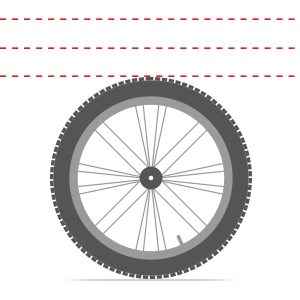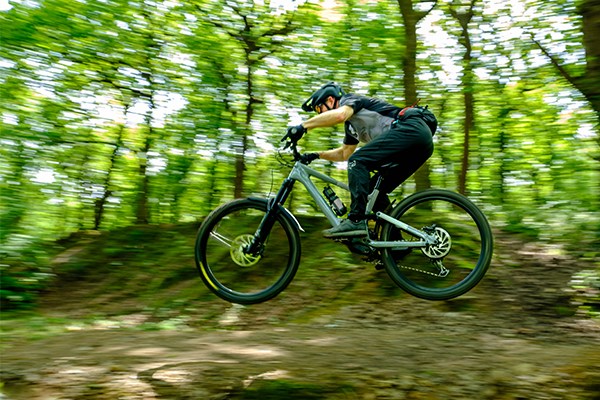Is a full-suspension mountain bike right for me?
If you’re new to the world of cycling, we highly recommend taking a look at our bike buying guide overview or our mountain bike buying guide to help you decide what type of bike is right for your needs.
When you’re choosing a full suspension mountain bike, there are a few things to look out for which can help you to work out the quality and performance you can expect from a particular model.
Suspension travel & usage
Depending on the type of mountain bike riding you’ll be doing, you may want to have longer or shorter suspension travel on your bike:
|
Travel |
Usage |
Pros |
Cons |
|---|---|---|---|
|
Up to 120mm |
XC |
Lightweight & efficient pedalling for long-distance rides |
Short travel is less capable on rough & demanding trails with large jumps & drops |
|
120 – 150mm |
Trail |
Lightweight, balance of climb-friendly efficiency & rough-descent capability |
More weight than a shorter travel bike & less efficient climbing. Less capable on descents than a longer travel bike |
|
150-180mm |
Enduro |
Capable of covering difficult & technical downhill sections. Wide enough gear range for climbing |
Heavier & significantly less efficient at climbing compared to shorter travel bikes |
|
180mm + |
Downhill |
Designed for highly technical & high-speed descents, with big drops and large jumps |
Heavy, and inefficient at climbing. Limited gear range means most climbs will require pushing the bike |
Frame material
Full-suspension MTB frames are mostly made from either aluminium or carbon fibre, with each material having its own benefits & drawbacks.

Aluminium is lightweight, stiff, strong, and easy to manufacture. Manufacturers often develop their own aluminium alloys, such as ALUXX by Giant. Aluminium is found on a wide range of bikes, from entry-level & enthusiast bikes, right the way up to top-spec racing bikes.

Carbon fibre is lighter, stiffer, stronger, and more expensive than aluminium. The most affordable carbon bikes typically use medium strength carbon fibres, while the most expensive bikes use stronger ‘high modulus’ carbon. Carbon fibre frames are found on enthusiast-level bikes, right up to high-performance bikes designed for racing.
Groupset & drivetrain
Mountain bike groupset components are typically supplied by either Shimano or SRAM, with additional manufacturers like Formula, Hope, Magura, Tektro and TRP supplying brake systems. Shimano & SRAM both produce a range of groupsets to suit different budgets. The hierarchy table here compares the different Shimano & SRAM groupsets to determine which bikes offer the best performance.
A bike’s groupset, or drivetrain, is where the biggest difference in component quality is seen. A complete groupset comprises of the following parts:
- Chainset (aka Crankset)
- Bottom bracket
- Brakes
- Brake levers
- Shifters
- Front & rear derailleur
- Chain
- Cassette
 |  | |
|---|---|---|
| Professional |
11
 |
12
 AXS Eagle 12
 AXS Eagle |
|
12
 |
11
 11
 |
|
|
11
 |
||
| Enthusiast |
12
 |
|
|
11
 |
10
 |
|
|
10
 |
11
 |
|
| Entry |
9
 |
12
 Eagle |
|
9
 |
9-10
 |
|
|
9
 |
9-10
 |
|
|
7
 |
7-10
 |
Wheel size
You’ve probably noticed that a lot of mountain bikes come in a choice of wheel size, mainly a 27.5 inch wheel (also known as a 650B wheel) or a 29inch wheel (known as a 29er). Although there are still bikes which use 26 inch wheels, these are gradually being phased out on all but the smallest bikes. The difference between these wheel sizes can have a dramatic effect on the way a bike feels and handles out on the trail.

27.5inch wheels are smaller and lighter than 29er wheels, which makes them more agile and gives the bike a more responsive & playful nature. On the other hand, the smaller wheel size rolls less efficiently than the larger size, making the bike more prone to losing speed over rough ground and making it a little slower when climbing.

29er wheels have a bigger rolling radius which makes them naturally smoother over rough ground. For this reason, a 29er mountain bike often requires less suspension travel than smaller wheeled alternatives. The downsides are an increase in weight, and the larger diameter wheels generate stronger gyroscopic forces, making the bike more stable, but less agile and responsive whilst manoeuvring.

26 inch wheels were once the go-to wheel size on adult mountain bikes. However, they are now typically only found on the smallest frame sizes, and on junior bikes. 26 inch wheels are lightweight and give the bike very agile handling. The downsides to 26 inch wheels are their poor rolling resistance on rough ground, and the reduced contact patch due to the smaller wheel circumference.
Suspension components
Mountain bike suspension components (i.e. the fork or rear shock absorber) are also a way to identify the quality of a bike. While Fox and RockShox are the most common manufacturers, there are a number of brands producing suspension components for mountain bikes.
Entry level full suspension mountain bikes (up to approximately £1300) may come supplied with a fork & rear shock supplied by SR Suntour, X-Fusion or RockShox. These components will allow a limited amount of adjustment, including:
- Coil spring preload / air spring pressure adjustment
- Lockout switch
- Rebound damping adjustment on models towards the top of the price range.
Mid-range & enthusiast bikes (up to approximately £3500) use components from brands including Fox, RockShox and Manitou. At this level, suspension components have features like:
- Preload adjustment / air spring pressure adjustment
- Rebound damping adjustment
- Lockout switch
- Multi-position ‘mode’ switch
- Components towards the top end of the enthusiast price range may also feature compression damping adjustment as well.
Top of the range & competition spec bikes (over £3500) also use components from Fox, RockShox & Manitou, with a few select models using parts from Ohlins. At this price, suspension components have features including:
- Coil spring preload adjustment / air spring pressure adjustment
- High & low speed rebound damping adjustment
- High & low speed compression damping adjustment
- Lockout switch
- Multi-position 'mode' switch
- Advanced low-friction coatings (e.g. Fox’s golden-coloured Kashima coating)





